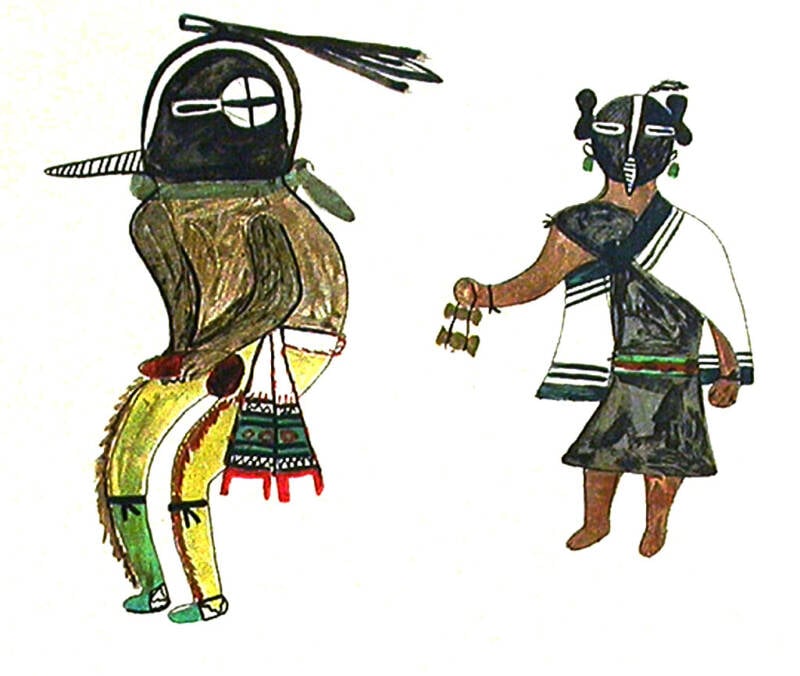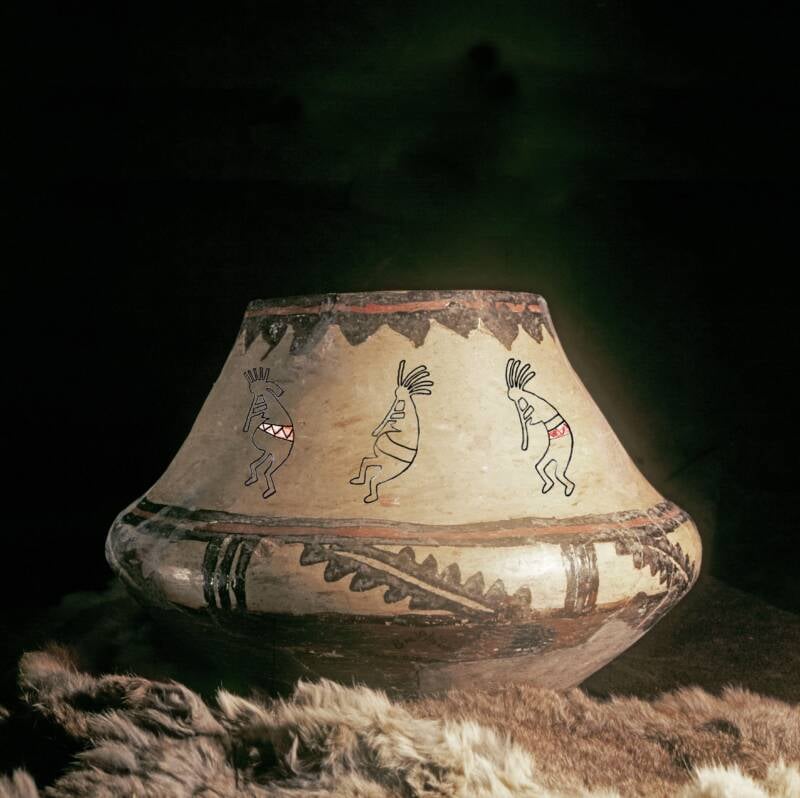A fun-loving fertility deity honored in multiple Southwestern Native American tribes, Kokopelli's image has recently been commodified to sell shirts, outdoor gear, and beer.

Cannon Photography LLC / Alamy Stock PhotoA depiction of Kokopelli on a Sand Island petroglyph panel in Southeast Utah.
Among some Native American cultures in the southwestern United States, there are stories of a deity known as Kokopelli.
A kachina, or spirit, Kokopelli is said to preside over fertility and agriculture, his flute tunes chasing the winter away and welcoming in the spring each year. His name is often invoked in marriage ceremonies, and the god himself is sometimes depicted with a partner of his own.
Today, his image has been used to sell everything from beer to t-shirts to outdoor gear, but some sources claim Kokopelli has appeared on pottery and cave walls since at least 750 C.E.
And with his image being used so frequently by larger brands, one question remains: Is he being accurately represented?
Kokopelli In Native American Folklore
Long before Kokopelli was being used to sell rafts and pizza, he was a figure celebrated by Pueblo cultures as a god of fertility, agriculture, and music.

Wikimedia CommonsKokopoli and his female counterpart, Kokopelmana.
Kokopelli is revered among the Hopi, a Pueblo group who live primarily in the northwestern region of Arizona. The word Hopi means “The Peaceful People,” or “behaving one, one who is mannered, civilized, peaceable, polite, who adheres to the Hopi Way.” This sentiment is often expressed in their various myths.
Of course, it becomes difficult to linearly or definitively explain all of Hopi mythology, for a number of reasons.
Firstly, these tales were told via oral tradition for centuries. Different villages or families may have put their own twists on each tale, so the meaning of Kokopelli and other figures may vary from village to village. Secondly, the Hopi were sometimes willing to incorporate outsider perspectives into their own mythology if they aligned with their beliefs.
It should also be noted that in Hopi culture, “Kokopelli” is reportedly something of a broad term that refers to two kachina figures — one male, one female — known as Kokopoli and Kokopelmana.
Of course, the Hopi are not the only Native American group to venerate Kokopelli. He also regularly appears in the legends of the Taos, Zuni, and Acoma peoples, among others. His name also has slight variations, depending on who is telling his story.
Depictions Throughout History
In most legends, Kokopelli serves a similar role. He is said to have domain over fertility, carrying unborn children on his back and distributing them to human women. He is likewise often associated with animal reproduction. Sometimes, he is accompanied by various animals such as rams, deer, snakes, lizards, or insects.

Buddy Mays / Alamy Stock PhotoThe fertility god Kokopelli, here represented as a female rather than a male, painted on a 1,000-year-old pottery bowl in New Mexico.
As a deity of agriculture, Kokopelli is said to chase away the winter by playing his flute, each year ushering in the spring and symbolizing the newfound growth that accompanies it. He is also sometimes said to carry bags of seed on his back. As he travels, he scatters the seeds throughout the land.
While images of Kokopelli can vary, the most common form attributed to him is one of a hunch-backed flute player with a festive crest on his head, posing as if he is dancing.
In ancient petroglyphs, a figure now associated with Kokopelli was frequently drawn with an abnormally long, erect phallus, meant to symbolize the “seeds” of human fertility. Over time, however, this depiction seems to have fallen out of use.
Another common association with Kokopelli is the production of maize, which was of vital importance to many Native American groups, such as the Anasazi, who welcomed Kokopelli during the corn planting season.
The Zuni, meanwhile, believe Kokopelli to be a rain priest, able to summon the rains at any time and therefore bless a harvest.
By the 1990s, however, Kokopelli had come to take on new associations as various brands around the world adopted his image — often in ways that did not accurately represent the customs of those who revere Kokopelli.

Matthew Timothy Bradley/Wikimedia CommonsA god of fertility, Kokopelli historically was associated with phallic imagery.
How Kokopelli Became A Pop Cultural Icon
If you were starting to feel like you’ve seen Kokopelli somewhere before, it’s probably because you have. While most people may not be aware of the folklore behind the image, it’s likely that you’ve seen Kokopelli on anything from camping gear to T-shirts to beer.
This commodification of the image has only muddied the waters further in terms of the original meaning of Kokopelli.
In fact, some have even argued that the depiction of Kokopelli as a flute player is entirely incorrect. Some scholars suggest that sometime around the 1920s, the Kokopelli figure was merged with another being known as the Fluteplayer.
If that’s the case, the kachinas known as Kokopelli likely didn’t appear in early rock art at all. Instead, the hunchbacked figure in those drawings was the Fluteplayer.
“To the members of the Fluteplayer clan, rock art depictions of this symbol indicate that their ancestors left their marks to show the routes of their migrations,” Edge of the Cedars State Park manager Teri Paul told The Salt Lake Tribune in a 2009 interview.
Paul worked closely with Hopi elders to develop a traveling exhibit on Kokopelli — which shed some light on this folkloric figure.
“We got an interesting reaction from some people who saw the exhibit but did not want to believe that this is what Kokopelli and the Fluteplayer were,” said Paul. “We challenged a belief that they held dear and they didn’t like it. This is a childhood story that we came to love and wanted to be true, but wasn’t.”

Marek Uliasz / Alamy Stock PhotoKokopelli inflatable packrafts, used for fishing, expedition, or adventure racing.
Anthropologists may have confused Kokopelli and the Fluteplayer in the 1920s, but by the 1990s, when “bro culture” appropriated various elements of Native cultures, Kokopelli became a touchstone figure for selling graphic tees, skateboards, skis, beer, pizza, puka shell necklaces — just about anything under the sun.
The Lasting Appeal Of Kokopelli
Just why did Kokpelli become such a cultural phenomenon in the 1990s? Random as it may seem, anthropologist Dennis Slifer identified several key reasons for this in his 2007 book Kokopelli: The Magic, Mirth, and Mischief of an Ancient Symbol.
“There is something archetypal and universally appealing about the flute player character,” Slifer explained. “The widely held beliefs that he was a fertility symbol, roving minstrel or trader, rain priest, shaman, hunting magician, trickster, and seducer of maidens have contributed to his popularity.”
Slifer compared Kokopelli to other prominent musician archetypes from around the world, including Orpheus, Pan, Krishna, and the Earth Mother, all of whom have had similarly significant impact worldwide.

RSBPhoto / Alamy Stock PhotoThe meaning of Kokopelli has been muddied over time.
It should also be noted that the 1990s saw other Native American iconography surge in popularity as well. During this time, New Ageism attracted many new followers, and Native American imagery — including Kokopelli — came to represent New Age ideals like the “free spirit” and individualism.
The unfortunate truth of this, however, is that as his image has been appopriated, Kokopelli’s origins and true nature have been hidden behind a veil of commercial indulgence. The allure of Kokpelli is undeniable, but it’s important to remember where he really came from.
After learning about Kokopelli, the Pueblo fertility deity, read about the seven most terrifying creatures from Native American folklore. Then, read these nine chilling Native American ghost stories that are sure to send shivers up your spine.






